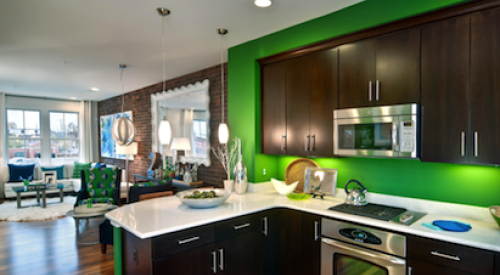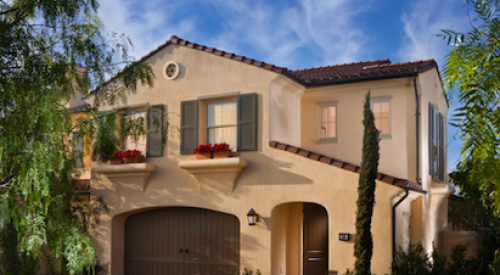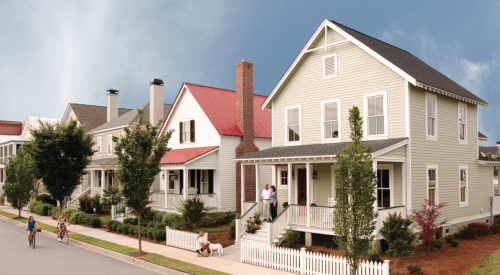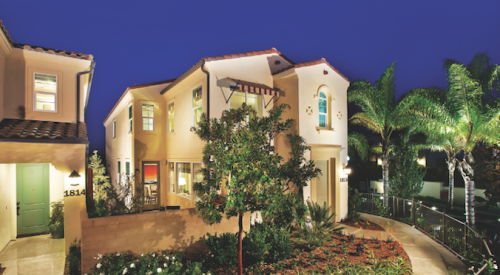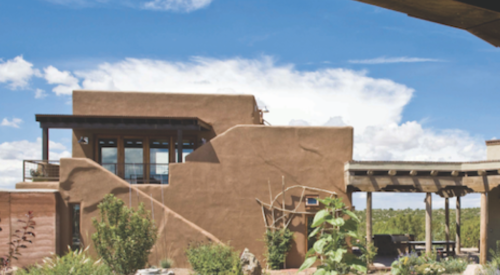|
©2004 Michael O'Callahan
Designer Steve Kubitschek and builder Brian Purcell spent many weekends driving through the older neighborhoods of Oakland, Piedmont and Berkeley, Calif., compiling a photo library of vernacular housing styles. From that, Kubitschek designed 16 plans with French Country, Tudor, Mediterranean, American Traditional, French Tudor, Craftsman and Italian Villa elevations but “modern, livable interiors,” he says.
|
|||||||
|
|
|
|
All the homes, such as this one (above) in a French Country style, feature custom front doors in Mexican mesquite, Bolivian cedar or alder from Oregon. Several of the mesquite doors come from 100-year-old reclaimed wood with a rustic finish, scars and holes from old iron nails, or clavos. Although they look custom, all garage doors are off-the-shelf panel doors. Purcell’s trim carpenter applied trim to each to create the appropriate look for each architectural style.
Interior details such as a progression of arches (below), tile insets in the wood floors and a built-in bar off the great room give the homes at Woodside Glen a very custom feel. Most ceilings in this home, a French Country, are 10 feet but pop up to 12 1/2 feet in the great room to add drama and increase the sense of spaciousness.
It’s the typical builder story: Find a great piece of land, spot a market segment to which nobody else delivers and pick the right product. Easy, right? Not when NIMBY neighbors get involved.
Opportunities
Brian Purcell, owner of BP Equities and its Bayview Builders subsidiary, has been building custom and semicustom homes in the San Francisco area for 20 years, so he’s intimately aware of the area’s shortage of good land available for home building. That’s why he jumped at the chance to buy a prime piece in Oakland near where he grew up. While he won’t name the price, he says he “got a very good deal, but in the end, I earned it” — wading through a seven-year entitlement process.
Woodside Glen — so named because of the redwood groves in nearby Joaquin Miller Park — nestles between two subdivisions from the 1930s and ’50s. Easy freeway access, proximity to dining and shopping, and sweeping views of the Bay area make one wonder why the urban infill site remained undeveloped for so long. Purcell says another builder owned the 13.5-acre parcel for 40 years but failed to get proposed apartment developments approved and, having retired and moved out of state, liquidated his assets.
Add fierce housing demand and buyers willing to spend money to a desirable site, and you have a great match — as long as you offer homes that buyers want. Designer Steve Kubitschek made sure of that. Drawing on some of the housing styles — American Traditional, Craftsman, Tudor and Mediterranean — found in Oakland, Piedmont and Berkeley, he created 16 plans — practically a unique plan for each of the 21 oddly shaped lots, which range from 8,800 to 17,000 square feet.
Obstacles
A strong, vocal coalition of neighbors opposed to any development on the site presented a serious barrier. After doing a preliminary site plan and renderings of potential houses, Purcell mailed them to the owners of property within 300 feet of the site and requested a meeting.
“The meeting was very difficult from the beginning,” Purcell says. The attendees, some of whom had had too much to drink, says Purcell, did not listen and instead voiced emotional appeals to “go build somewhere else.”
The city of Oakland approved Purcell’s plan, but the neighbors appealed and then sued BP Equities and the city, citing inadequate reporting of the raptor, geological, geo-technical, hydrological, herpetological, entomological and biological studies Purcell had done in compliance with the California Environmental Quality Act. To pacify the neighbors, the city required Purcell to subject many of the studies to peer review.
As part of an out-of-court settlement, Purcell reduced the project from 65 homes to 21 and donated the property’s 8.7-acre hillside portion to the city. He also created a new public street, added an extra fire hydrant, widened the private driveways, and provided one-hour exterior walls, Class A roofs and fire sprinklers in every home.
Outcome
With Woodside Glen sitting at the end of a dead-end street and Bay-area buyers unaccustomed to shopping for new homes — because they simply don’t exist in the built-out area — Purcell was concerned that the community would not get much buyer traffic. He knew he needed help from the real estate community, so he held an open house for brokers before the public opening to get their endorsement of the project.
“As a result, during the following weekend, we had more than 400 groups of people tour the project site and the model,” Purcell says. He sold all six homes of the first release and “two additional homes because buyers came in with offers we could not refuse.”
After pushing this community of just 21 homes through NIMBY hoops for seven years, Purcell sold more than a third of them in nine days. With the second phase of four homes released in mid-February and the final phase set to release soon, Purcell isn’t resting on his laurels - he’s looking for his next perfect piece of land.

